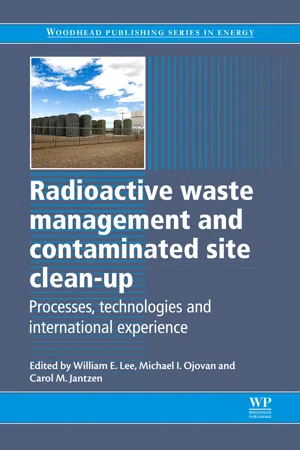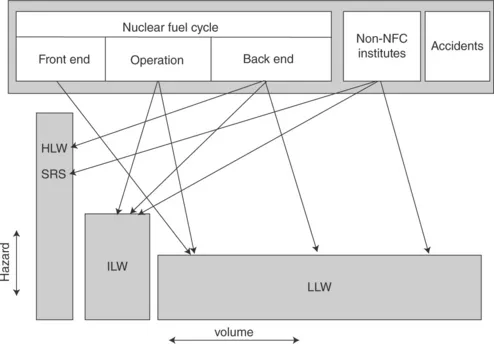
Radioactive Waste Management and Contaminated Site Clean-Up
Processes, Technologies and International Experience
- 912 pages
- English
- ePUB (mobile friendly)
- Available on iOS & Android
Radioactive Waste Management and Contaminated Site Clean-Up
Processes, Technologies and International Experience
About This Book
Radioactive waste management and contaminated site clean-up reviews radioactive waste management processes, technologies, and international experiences. Part one explores the fundamentals of radioactive waste including sources, characterisation, and processing strategies. International safety standards, risk assessment of radioactive wastes and remediation of contaminated sites and irradiated nuclear fuel management are also reviewed. Part two highlights the current international situation across Africa, Asia, Europe, and North America. The experience in Japan, with a specific chapter on Fukushima, is also covered. Finally, part three explores the clean-up of sites contaminated by weapons programmes including the USA and former USSR.Radioactive waste management and contaminated site clean-up is a comprehensive resource for professionals, researchers, scientists and academics in radioactive waste management, governmental and other regulatory bodies and the nuclear power industry.
- Explores the fundamentals of radioactive waste including sources, characterisation, and processing strategies
- Reviews international safety standards, risk assessment of radioactive wastes and remediation of contaminated sites and irradiated nuclear fuel management
- Highlights the current international situation across Africa, Asia, Europe, and North America specifically including a chapter on the experience in Fukushima, Japan
Frequently asked questions
Information
Fundamentals of radioactive waste (RAW): science, sources, classification and management strategies
Abstract:
1.1 Introduction
1.2 Controlled and uncontrolled wastes

Table of contents
- Cover image
- Title page
- Table of Contents
- Copyright
- Contributor contact details
- Woodhead Publishing Series in Energy
- Foreword
- Preface
- Chapter 1: Fundamentals of radioactive waste (RAW): science, sources, classification and management strategies
- Chapter 2: Radioactive waste (RAW) categories, characterization and processing route selection
- Chapter 3: International safety standards for radioactive waste (RAW) management and remediation of contaminated sites
- Chapter 4: Technical solutions for the management of radioactive waste (RAW): overview and methods of selection
- Chapter 5: Irradiated nuclear fuel management: resource versus waste
- Chapter 6: Radioactive waste (RAW) conditioning, immobilization, and encapsulation processes and technologies: overview and advances
- Chapter 7: Assessing and modelling the performance of nuclear waste and associated packages for long-term management
- Chapter 8: Remediation of radioactively contaminated sites and management of the resulting waste
- Chapter 9: Safety and risk assessment of radioactive waste (RAW) and contaminated sites
- Chapter 10: Russia: experience of radioactive waste (RAW) management and contaminated site clean-up
- Chapter 11: Ukraine: experience of radioactive waste (RAW) management and contaminated site clean-up
- Chapter 12: Czech Republic, Slovak Republic and Poland: experience of radioactive waste (RAW) management and contaminated site clean-up
- Chapter 13: Nordic countries: experience of radioactive waste (RAW) management and contaminated site clean-up
- Chapter 14: Germany: experience of radioactive waste (RAW) management and contaminated site clean-up
- Chapter 15: France: experience of radioactive waste (RAW) management and contaminated site clean-up
- Chapter 16: England and Wales: experience of radioactive waste (RAW) management and contaminated site clean-up
- Chapter 17: Scotland: experience of radioactive waste (RAW) management and contaminated site clean-up
- Chapter 18: United States: experience of radioactive waste (RAW) management and contaminated site cleanup
- Chapter 19: Canada: experience of radioactive waste (RAW) management and contaminated site cleanup
- Chapter 20: South Africa: experience of radioactive waste (RAW) management and contaminated site clean-up
- Chapter 21: Republic of Korea: experience of radioactive waste (RAW) management and contaminated site clean-up
- Chapter 22: China: experience of radioactive waste (RAW) management
- Chapter 23: Japan: experience of radioactive waste (RAW) management and contaminated site clean-up
- Chapter 24: Fukushima: The current situation and future plans
- Chapter 25: Management of radioactive waste (RAW) from nuclear weapons programmes
- Chapter 26: Modeling and strategy approaches for assessing radionuclide contamination from underground testing of nuclear weapons in Nevada, USA
- Chapter 27: Remote monitoring of former underground nuclear explosion sites predominantly in the former USSR
- Index